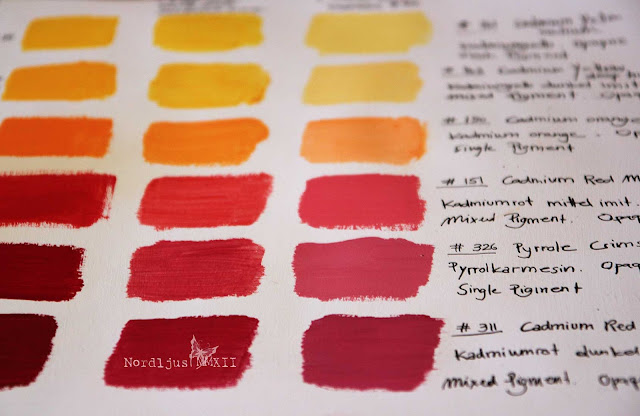I had meant to do this for some time: colour charts., examples of paint into my sketchbook for reference It's good to know what's in your paintbox, and how the colours actually look on paper, (often quite different than in the tube), and how they mix and match which each other.
So finally, I took out all the paint tubes...
... and started painting small squares of colour examples and mixing them to get an overwiev of what's in my paintbox, adding some information about pigments, opacity, and of course their names. I find paints and pigments a most fascinating subject.
Pigments were traditionally made by grounding natural substances, such as plants, stones, minerals, insects and animals and, according to some myths(?) even cow piss (
Indian Yellow). Modern pigments are mostly manufactured synthethically. The
Colour Index International (CII) is a standard for identifying pigments used in manufacturing colours.
: Some single pigment colours, such as
Cadmium Red for example, are also available in a "hue" version, such as
Cadmium Red Hue. These hue colours are mixed pigment substitutions of the original colour. Maybe the original colour is very expensive, or that it's lightfastness is not so good, and a substitute can therefore be useful. (See
here and
here for some more information).
Lake pigments: Pigments are usually made by grounding a substance which can then be mixed with a binder to make paint. But some substances can't be turned into pigments, they can only produce dyes. In order to produce pigments from dyes, the dye has to be fixed on to a carrier before it can be mixed with a binder to turn it into paint. These pigments made of dyes are called lake pigments. A well-known lake pigment is Rose Madder Lake, made of the madder plant. It's synthetic form is known as Alizarin Crimson. Paint names can often be very confusing, as they often have a whole range of different names. It also seems that for watercolours, the older, more traditional names are preferred (such as Rose Madder or Chinese White for example), while in acrylics, it's all the new and often fancy-sounding name (Alizarin Crimson, Zinc White).

I was somewhat surprised to find out that Raw Umber, Burnt Umber, Raw Sienna and Burnt Sienna are all made of the same pigment (PBr 7, Brown Iron Oxide). That the two Umbers and the two Siennas are made from the same makes of course perfect sense. But the Umbers and the Siennas look quite different, so I assumed it would be different pigments. But there you go. It's not just the pigment itself that makes the colour, it's the whole chemistry behind them too. And I've never been particularly good at chemistry, I'm afraid...
My palette was getting more and more colourful during my colour sample progress. I should definitely clean it one of these days. But I think it looks rather cheerful at the moment.
I really do find colour, pigments, the making of paints, an extremely fascinating topic. I recently read Philip Ball's wonderful book Bright Earth, the most fascinating book on the topic, I think, and one of my absolute favourites. How lucky we are today that we can just walk into a shop and pick and choose from a whole range of colours which conveniently come in tubes and pots of various sizes. No limited palette, no toxic paints, no sheeps' bladders to keep your paints from drying out (I'm forever grateful to the guy who intenved the metal tube in the 19th century!!).
Now of course you can ask if it is really necessary for an artist to know all about the hsistory and chemistry of paints and pigments. The answer is no, not really. You can happily paint and create magnificent pictures all your life whithout having the least idea about what's in your paint or how they are made. But then it doesn't hurt to know a bit more about our paints, which are, after all, the most important part of every painter's equipment. Personally, I find it very useful to know more about my paints. It helps me understand them better, and to appreciate and value them even more, knowing their history and origins. (It was also very interesting to learn, for examples, that all the big chemical and pharmazeutical companies that are around here in the north of Switzerland and in neighbouring south Germany started as dye manufactures. Producing dye was a big and important business for centuries, and artists' pigments really just their by-product).
At times, I had been frustrated with my paints. It looks lush and deep and opaque in the tube and on my palette, but on canvas or paper, it turns transparent, thin and several shades lighter. Why can't all they all just have the same consistency? The same opaqueness? And just look on paper as they look in the tube? Well, you can get that if you buy cheap paints with next to now pigments in them. But good paints have lots of pigments in them, and pigments are made up of all kinds of materials and sources, and often in complacated processes, and therefore they behave differently. And knowing about the different properties of different pigments also allows you to use them in different ways, taking advange and making the best of their different qualities. Learning more about all these things hasn't changed what or how I paint, but it has certainly changed my relationship with my paints.

























































